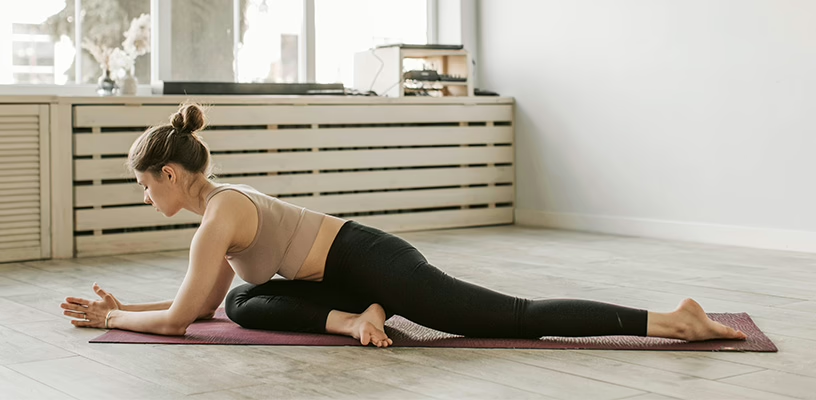Pre-Pregnancy Workout Plan: 13 Safe Exercises to Try
Before trying to get pregnant, think about rolling out the yoga mat and sneaking in a pre-pregnancy workout.

Pregnancy can be physically demanding, to say the least. Don’t overlook the importance of getting your body up to the task.
While prenatal vitamins and doctor visits are important, getting the right kind of exercise can also significantly improve your fertility, pregnancy outlook, and postpartum recovery process.
Why exercise matters when you're trying to conceive
You’re about to endure a 9-month-long endurance test. Pregnancy puts a lot of stress on your body, including your heart, which needs to pump 50% more blood during it.
All this extra work may cause heart palpitations, which you can partly manage by maintaining a healthy weight, meditating, or doing yoga. 1
Regular exercise also provides benefits before you conceive and during pregnancy, such as:
- Boosting fertility: Exercise can help you prepare for pregnancy by balancing your body’s hormones, improving your circulation, and reducing your stress, all of which contribute to the factors affecting your fertility. 2
- Reducing pregnancy complications: By managing your weight with exercise, you’ll reduce the risk of gestational diabetes and preeclampsia (swelling and high blood pressure during pregnancy). Exercise can also relieve common uncomfortable pregnancy symptoms like lower back pain, piles, and swollen ankles. 3 4
- Building confidence: Working out improves your physical health and releases endorphins, helping you relax and improve your mental health. 5 You may feel stronger and more confident in handling the difficulties of your pregnancy.
These benefits also extend to the postpartum period. During pregnancy, it’s normal for your abdominal muscles to stretch apart to accommodate your growing baby. However, they can separate too much, resulting in diastasis recti. This may affect your posture, core strength, and lower back during postpartum. 6
Fortunately, you can lower your chances of developing diastasis recti with exercises that target your core. 7 You can also ask your doctor for safe diastasis recti exercises to combat it postpartum. 6
How much exercise is enough when trying to get pregnant?
As a rule, you’ll want to aim for at least 150 minutes of moderate to intense aerobic exercises like fast-paced walking and swimming each week (30-minute sessions five days a week). If that feels like too much, you can always break these sessions down into ten-minute segments. 8
While exercising enough can be challenging, it doesn’t have to feel like a chore. Find an activity you enjoy, like gardening or housework. As long as it gets your heart pumping, it’ll help you stay in shape
Exercise also boosts male fertility
It’s not just moms-to-be who need to work out. Regular exercise also helps men produce healthy sperm. 9 Keep your swimmers in check with exercises like walking, jogging, bicycling, or lifting weights.
What kinds of exercise should you do when trying to get pregnant?
If you’re trying to get pregnant, it’s important to choose the right exercises to support your body without adding unnecessary stress. Focus on low-impact, core-strengthening workouts, and always be mindful of your body and energy levels.
Here are a few exercises you can get started with:
4 low-impact pre-pregnancy workouts
While high-intensity workouts aren’t strictly off-limits, your routine should be well-rounded, with different kinds of exercise to avoid putting too much strain on your body.
As mentioned, walking and swimming are beneficial. You can swap out your intense Burpees and sprints for:
- Yoga: This exercise is a great way to build core strength while improving your flexibility and reducing stress. This will continue after you conceive; prenatal yoga has many benefits throughout your pregnancy.
- Cycling: Indoor stationary bicycling is a safe way to exercise while avoiding the potential for injury, like falls or accidents
- Chair exercises: Low-impact movements like seated leg extensions, shoulder rolls, and knee lifts are great ways to sneak in exercise if you have mobility issues or need to start your fitness journey slowly.
- Gentle martial arts: Low-impact martial arts like tai chi focus on slow, smooth movements that help reduce stress and relax you (no flying kicks right now).
3 core-strengthening pre-pregnancy exercises
Building a strong core goes beyond a few crunches and planks. You’ll need to incorporate exercises that improve your stability and stamina into your routine.
These exercises will protect your core during pregnancy, reduce back pain, and aid your postpartum recovery. You could try:
- Hinges: With this movement, you’ll bend down at your hips (not your back or knees), then return to your starting position. Think of your movement when you bend over to pick up something from the floor.
- Squats: To squat correctly, you’ll need to stand with your feet shoulder-width apart. Keep your chest up and back straight while bending your knees as if you’re sitting back in a chair, ensuring your knees don’t extend past your toes.
- Pelvic floor exercises: Kegels are important, but you can also integrate other exercises that target your pelvic floor muscles. You can try exercises like the happy baby pose, seated hip rotations, and pelvic tilts.
3 strength training exercises for pre-pregnancy
Adding strength training to your pre-pregnancy routine lays the foundation for a healthier, more comfortable pregnancy and prepares you for the physical demands of carrying a child.
Choose exercises that target multiple muscle groups, and don’t be afraid to change them up to suit your fitness level.
Here are some of the most effective strength-building exercises:
- Planks: You’ll need to lie face down, then lift your body off the ground while balancing on your forearms and toes. Keep your body straight and engage your core to avoid letting your hips droop. If you’re a beginner, try holding this position for 20–30 seconds.
- Push-ups: To do a push-up properly, start in a plank position with your hands slightly wider than shoulder-width apart. Push yourself up and down while bending your elbows and keeping your body in a straight line. If you’re having difficulty, you can start with wall push-ups or kneeling push-ups.
- Modified weight training: You can add weights to your exercise for more of a challenge. If you’re a beginner, start with lighter weights with more repetitions while doing lunges, squats, and bridges.
3 endurance exercises
Your endurance plays an important role in your wellness throughout your pregnancy, labor, and delivery. Try adding exercises that improve your stamina without overexerting yourself:
- Longer walks or hikes: This exercise, especially when done over varied or uneven terrain like uphill trails, can engage your entire cardiovascular system and strengthen your muscles, boosting your endurance over time.
- Pilates: These activities involve breathing deeply while performing controlled movements that focus on strengthening the core, improving flexibility, and promoting proper posture.
- Dance: If you’re looking for a fun and effective exercise, try adding dances like Zumba, aerobics, or even ballet to your fitness routine.
How to avoid overexerting yourself
While exercise is important, you need to find the right balance, especially if you weren’t particularly active before.
Pay attention to your body’s signals and dial things back if you:
- Become excessively tired
- Become irritable
- Experience muscle or joint pain
- Have trouble sleeping
- Notice any changes to your menstrual cycle
Always be careful when exercising. Pushing yourself too hard can result in unnecessary strain on your body, which could even hinder your efforts to conceive.
What are the dangers of overly strenuous exercise?
Although exercise does boost fertility, research suggests that too much physical stress can actually have the opposite effect in both men and women. 10
For instance, too much strenuous exercise can cause absent or irregular periods (a condition known as amenorrhea).
Tips for a safe and effective pre-pregnancy workout routine
Firstly, always check in with your doctor before adding any new exercises to your workout routine, especially if you have underlying health conditions. They’ll advise you on how to modify your routine if necessary.
You should also:
- Start slowly: If you’re new to exercise, it’s important to start at your level and gradually increase the intensity and length of your workouts as you progress.
- Stay hydrated: While you’re physically active and trying to conceive, you’ll need lots of water to flush out your kidneys and improve your fertile cervical fluid (which helps sperm swim more easily through the cervix and into the uterus). Aim to drink around 8–10 cups of water a day. 4
- Focus on proper form: The better your form is, the better your results will be. Conversely, using bad technique can increase your risk of injury and target the wrong muscles, rendering all your hard work ineffective.
- Incorporate rest days: Even if you’re exercising for most of the week, you should give your body time to recover by including rest days in your routine. If you’re following the recommended 30 minutes a day to reach the 150-minute goal, that means you’ll have two days off a week. It’s also necessary to take an extra break if you’re overexerting yourself.
Final thoughts
Preparing your body for pregnancy requires creating a well-rounded, comprehensive approach to your health, including a fitness routine best suited to your fitness level.
Listen to your body and don’t be afraid to tweak your workouts a little if you need. Preparing for the joy of carrying a baby is all the motivation you’ll need to get your sweat on!
Article Sources
- Cleveland Clinic. "Heart Palpitations in Pregnancy" Retrieved September 30, 2025.
- Your Fertility. "The role of exercise in improving fertility, quality of life and emotional wellbeing" Retrieved September 30, 2025.
- Cleveland Clinic. "Preeclampsia" Retrieved September 30, 2025.
- Fertility Network UK. "Conception Tips" Retrieved September 30, 2025.
- Harvard Health Publishing. "Exercising to relax" Retrieved September 30, 2025.
- Cleveland Clinic. "Diastasis Recti" Retrieved September 30, 2025.
- NASM. "How to Prevent Diastasis Recti (With Crunches)" Retrieved September 30, 2025.
- Office of Disease Prevention and Health Promotion. "Stay Active During Pregnancy: Quick Tips" Retrieved September 30, 2025.
- Cleveland Clinic. "Male Infertility" Retrieved September 30, 2025.
- Frontiers in Physiology. "Unraveling the complexity of the impact of physical exercise on male reproductive functions: a review of both sides of a coin" Retrieved September 30, 2025.







